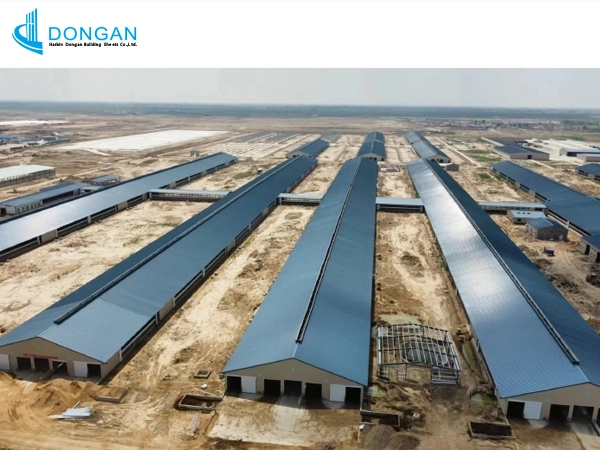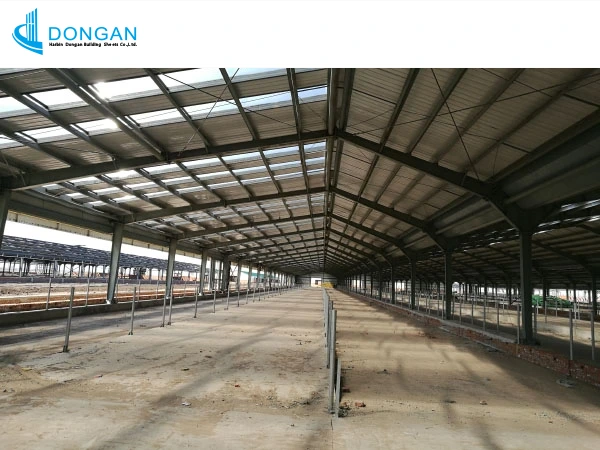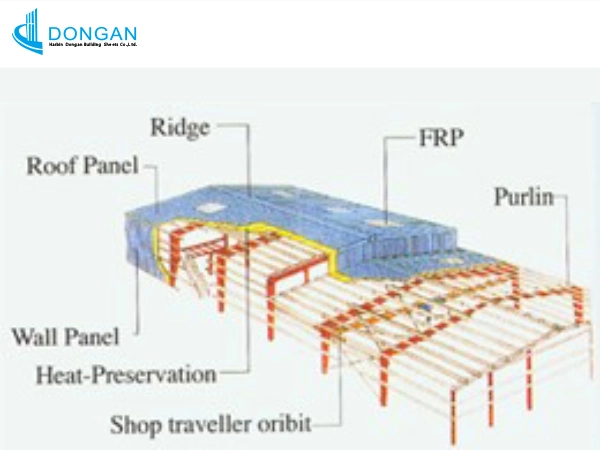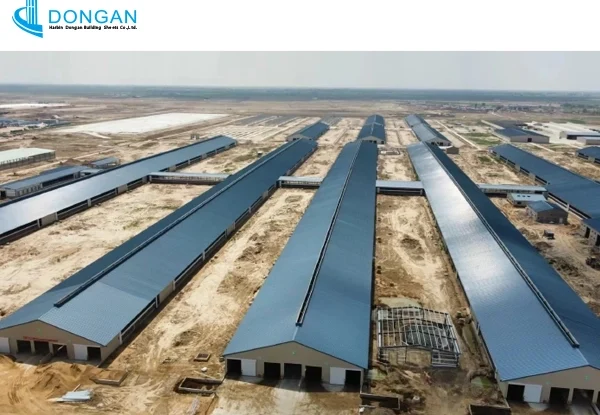When constructing industrial warehouses, aircraft hangars, or agricultural facilities across America, lightweight portal frame structures have become the go-to solution for engineers seeking cost-effective, durable, and adaptable building systems. Optimized for Google search visibility, this guide explores the critical components of portal steel frames, their engineering advantages, and real-world applications in US construction projects—from hurricane-resistant designs in Florida to seismic-proof warehouses in California.
1. Core Components of Lightweight Portal Frame Systems
Portal frames derive their strength from precision-engineered steel components working in unison. Here’s how each element contributes to structural integrity:
A. Vertical Columns: The Load-Bearing Backbone
- Materials: Hot-rolled H-beams (W-shapes per AISC standards) or square hollow sections (SHS).
- Function: Transfer vertical loads (dead loads, snow loads) to foundations while resisting lateral forces.
- US Adaptation: In seismic zones like California, columns often incorporate energy-dissipating base plates (e.g., SIMPSON Strong-Tie® connectors).

B. Rafters: The Horizontal Workhorses
- Design: Welded box sections for spans >100 ft (common in Midwest distribution centers) or tapered beams for aesthetic commercial projects.
- Innovation: Cold-formed Z-purlins (12-ga G90 galvanized steel) spaced at 5 ft OC optimize roof load distribution.
C. Knee Braces: The Stability Guardians
- Configuration: ASTM A36 steel angle braces arranged in X or K patterns.
- Performance: Reduce lateral drift by 40-60% in high-wind regions (tested to ASCE 7-22 standards).
D. Foundation Systems: Anchoring Reliability
- Solutions:
- Spread Footings: For stable soils in Texas oilfield facilities.
- Helical Piles: Ideal for flood-prone areas like Louisiana, installed in <4 hours per column.
E. Cladding & Insulation: Energy Code Compliance
- Wall Systems: 26-gauge standing seam metal panels with R-19 fiberglass batt insulation (meets IECC 2021 requirements).
- Roofing: TPO membranes with cool roof ratings (CRRC-certified) for Arizona solar heat mitigation.
F. Connection Technology: Bolted Precision
- High-Strength Fasteners: A325 bolts pretensioned to RCSC specifications.
- Digital Assurance: Laser-guided alignment ensures ±1/16″ tolerance—critical for LEED-certified projects.

2. Why American Contractors Choose Portal Frames
A. Speed-to-Completion Advantage
- Prefab components cut erection time by 50% vs. structural steel—a $2.3M Nevada data center completed in 18 weeks.
- No concrete curing delays (permit winter construction in Alaska).
B. Cost Efficiency Metrics
- Material Savings: 30% lighter than wide-flange systems = lower crane costs.
- Tax Benefits: 100% first-year bonus depreciation (IRS Section 179) for qualifying structures.
C. Resilient Engineering
- Miami-Dade County Approved: Withstands 170 mph winds (Category 5 hurricanes).
- Fire Resistance: UL-certified spray-applied FRP (1-hour rating for Ohio manufacturing plants).
D. Sustainability Edge
- Contains 93% recycled steel content (SEFA-certified).
- Enables solar panel integration (meets Inflation Reduction Act tax credits).

3. Case Study: Automotive Logistics Hub in Detroit, MI
Project Snapshot
- Size: 150,000 sq.ft with 60-ft clear span
- Challenge: Accelerated schedule for EV battery storage
- Portal Frame Solution:
- Used A992 steel columns with moment-resisting connections
- Installed 200-ton capacity mezzanine via castellated beams
- Achieved Net Zero Ready status with 500kW rooftop PV system
Outcomes
- 22% under budget ($4.1M total cost)
- Passed rigorous MIOSHA safety audits
- Reduced embodied carbon by 37% vs. tilt-up concrete
4. Navigating US Building Codes & Standards
Ensure compliance with these critical regulations:
- IBC 2021: Chapter 22 for steel framing requirements
- AISC 360: Chapter C for member design
- OSHA 1926.757: Erection safety protocols
- Buy America Act: Sourcing domestic steel for federal projects
5. Future Trends: Smart Portal Frames
A. Digital Twin Integration
Embedded IoT sensors (like Hilti Jaibot) monitor real-time stress levels in Chicago high-rises.
B. Robotics & AI
Autonomous welding drones used in Tesla’s Austin Gigafactory reduced labor costs by 18%.
C. Advanced Coatings
Graphene-enhanced epoxy extends maintenance cycles to 25+ years in coastal Virginia plants.
Conclusion: Engineering the American Landscape Smarter
From Texas logistics parks to Seattle tech campuses, lightweight portal frames are redefining US industrial architecture through smarter material use, code-compliant designs, and climate-specific adaptations. By leveraging modular precision and sustainable engineering, these systems deliver ROI that resonates with American contractors’ priorities—speed, savings, and resilience.







Leave A Comment